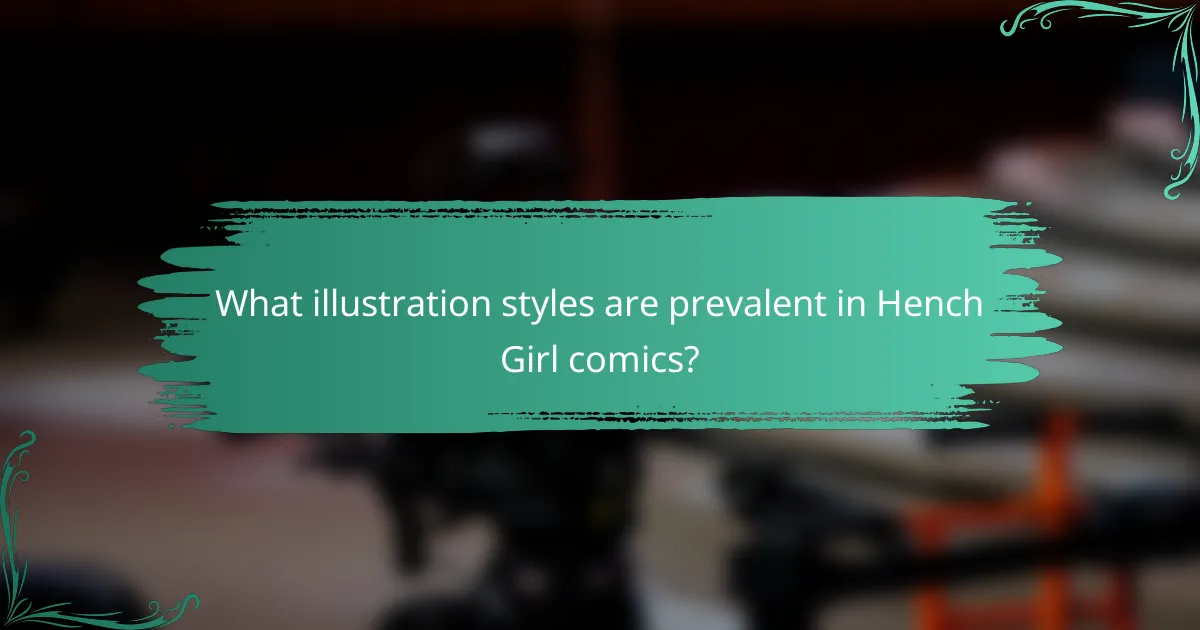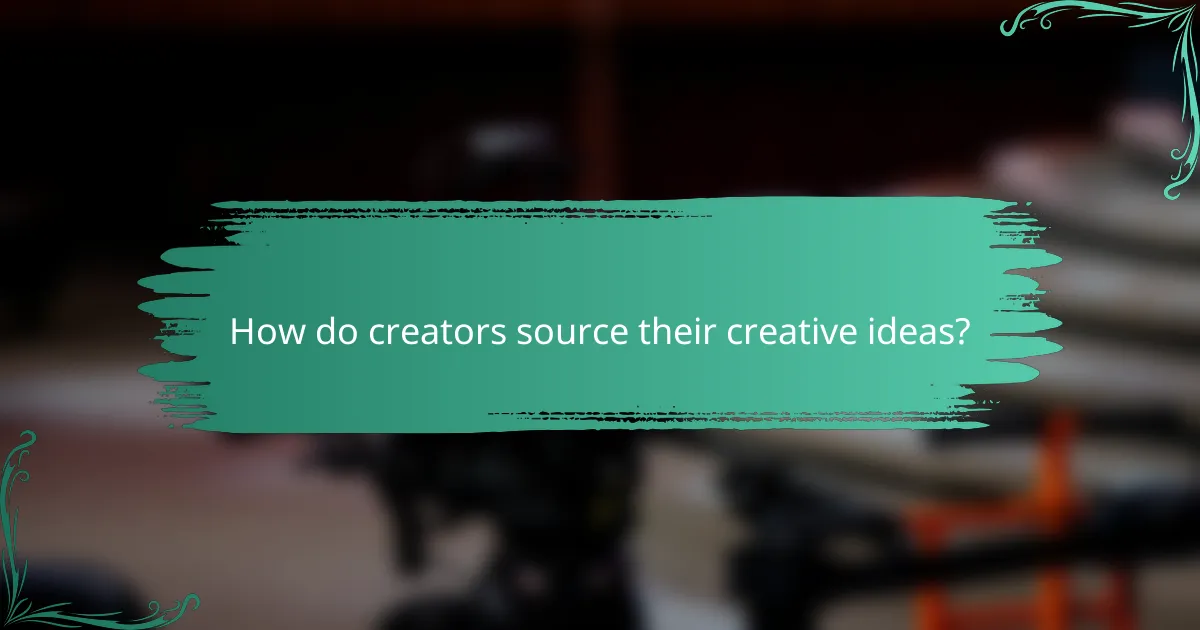The artistic inspirations behind Hench Girl comics are a vibrant fusion of superhero culture, feminist art movements, pop art, anime, and contemporary illustration trends. This eclectic mix results in dynamic illustration styles characterized by bold color palettes and innovative techniques that enhance both storytelling and character development. Creators often weave personal experiences and cultural research into their work, crafting unique narratives that resonate with a diverse audience.

What are the artistic inspirations for Hench Girl comics?
The artistic inspirations for Hench Girl comics draw from a diverse range of sources, blending various styles and movements to create a unique visual narrative. Key influences include superhero culture, feminist art movements, pop art, anime, and contemporary illustration trends.
Influence of superhero culture
Superhero culture significantly shapes the aesthetic of Hench Girl comics, often incorporating bold colors and dynamic action sequences. This genre’s emphasis on larger-than-life characters and dramatic storytelling resonates with the comic’s themes of empowerment and rebellion.
Artists frequently reference iconic superhero designs, adapting them to subvert traditional gender roles and highlight the complexities of female characters. This interplay between homage and innovation creates a fresh take on familiar tropes.
Feminist art movements
Feminist art movements have profoundly influenced Hench Girl comics, encouraging the exploration of women’s experiences and identities. These movements challenge stereotypes and promote the representation of strong female characters who defy societal norms.
Artists often draw inspiration from feminist icons and artworks, integrating themes of empowerment, resistance, and self-expression into their illustrations. This approach not only enriches the narrative but also fosters a deeper connection with readers.
Pop art and graphic novels
Pop art’s vibrant colors and commercial aesthetics play a crucial role in shaping the visual style of Hench Girl comics. The movement’s embrace of popular culture and consumerism allows for a playful yet critical examination of contemporary society.
Graphic novels, with their diverse storytelling techniques and artistic expressions, also contribute to the Hench Girl aesthetic. The blending of text and imagery in innovative ways enhances the narrative depth and engages readers on multiple levels.
Anime and manga styles
Anime and manga styles have become increasingly influential in Hench Girl comics, characterized by exaggerated expressions and dynamic action. These styles allow for a unique portrayal of emotions and movement, enhancing the storytelling experience.
Many artists incorporate elements such as panel layouts and visual storytelling techniques from these mediums, creating a distinct fusion that appeals to a broad audience. This influence also reflects the global nature of comic art today.
Contemporary illustration trends
Contemporary illustration trends emphasize versatility and experimentation, which are evident in Hench Girl comics. Artists often blend traditional and digital techniques to create visually striking and innovative designs.
Current trends, such as minimalism and mixed media, allow for a fresh approach to character design and backgrounds. This adaptability helps artists convey complex themes while maintaining a visually engaging style that resonates with modern readers.

What illustration styles are prevalent in Hench Girl comics?
Hench Girl comics often feature a mix of dynamic illustration styles that enhance storytelling and character development. Key styles include dynamic action poses, bold color palettes, and mixed media techniques that contribute to the unique visual identity of these comics.
Dynamic action poses
Dynamic action poses are essential in Hench Girl comics, as they convey movement and energy. Artists typically use exaggerated angles and perspectives to create a sense of urgency and excitement. This approach helps to engage readers and immerse them in the action.
When designing action poses, consider the character’s personality and the context of the scene. For instance, a confident character may have more aggressive stances, while a more cautious character might adopt defensive positions. Aim for a balance between realism and stylization to maintain visual interest.
Bold color palettes
Bold color palettes are a hallmark of Hench Girl comics, often reflecting the tone and mood of the narrative. Bright, saturated colors can evoke feelings of excitement and adventure, while darker shades may indicate tension or conflict. Artists frequently use contrasting colors to highlight key elements and draw attention to important scenes.
To create an effective color palette, consider the emotional journey of the characters. Use color theory principles, such as complementary colors, to enhance visual storytelling. Experimenting with various combinations can lead to striking results that resonate with readers.
Mixed media techniques
Mixed media techniques are increasingly popular in Hench Girl comics, allowing artists to blend traditional and digital methods for a unique look. This approach can include combining hand-drawn illustrations with digital enhancements, textures, or photography. The result is a visually rich and layered aesthetic.
When using mixed media, be mindful of maintaining a cohesive style. Ensure that the different elements complement each other rather than compete for attention. This can involve adjusting colors or textures to create harmony throughout the artwork.
Character design variations
Character design variations play a crucial role in Hench Girl comics, as they help to distinguish personalities and roles within the story. Artists often experiment with different body types, facial features, and clothing styles to create diverse and relatable characters. This variety enhances the overall narrative and fosters reader connection.
To develop compelling character designs, consider each character’s background and motivations. Incorporating unique visual traits can make characters memorable and engaging. Additionally, maintaining consistency in design throughout the comic is essential for clarity and coherence.
Digital vs. traditional methods
Both digital and traditional methods are utilized in Hench Girl comics, each offering distinct advantages. Digital tools provide flexibility and ease of editing, while traditional techniques can impart a unique texture and authenticity to the artwork. Many artists choose to combine both methods to leverage their strengths.
When deciding between digital and traditional methods, consider your workflow and comfort level with each medium. Digital methods may allow for faster production times, while traditional techniques can create a more tactile experience. Experimenting with both can help you find the best fit for your artistic style.

How do creators source their creative ideas?
Creators of hench girl comics often draw inspiration from a variety of sources, including personal experiences, collaborations, and cultural research. These influences help shape their artistic vision and storytelling approach, leading to unique and engaging content.
Personal experiences and narratives
Many artists tap into their own life stories and experiences to create authentic characters and plots. Personal narratives can provide emotional depth and relatability, making the characters more engaging for readers. For instance, an artist might explore themes of empowerment or resilience based on their own challenges.
Incorporating personal experiences can also help artists connect with their audience on a deeper level, as readers often resonate with genuine stories. This connection can enhance the overall impact of the comic.
Collaborations with other artists
Collaboration can significantly enrich the creative process, allowing artists to blend different styles and ideas. Working with others can introduce fresh perspectives and techniques that might not have been considered otherwise. For example, a hench girl comic might feature a co-creator who specializes in a distinct illustration style, adding variety to the visual narrative.
These partnerships can also foster a sense of community and shared purpose, motivating creators to push their boundaries and explore new themes together.
Community feedback and engagement
Engaging with the community is crucial for creators seeking to refine their ideas. Feedback from readers can provide insights into what resonates and what doesn’t, guiding future projects. Many artists use social media platforms to share drafts and solicit opinions, which can lead to valuable improvements.
Additionally, community engagement can help build a loyal fan base, as readers feel invested in the creative journey. This interaction often leads to a more dynamic and responsive storytelling approach.
Research on cultural themes
Exploring cultural themes can provide a rich backdrop for hench girl comics. Artists often research various cultures, myths, and social issues to create layered narratives that reflect diverse perspectives. This research can inspire character development and plotlines that resonate with a broader audience.
For instance, incorporating elements from folklore or contemporary social movements can add depth and relevance to the story, making it more engaging for readers who appreciate cultural nuances.
Social media trends
Social media plays a significant role in shaping creative ideas by highlighting current trends and popular themes. Artists often monitor platforms like Instagram and Twitter to identify what is capturing public interest. This awareness allows them to incorporate timely topics into their comics, ensuring they remain relevant and relatable.
However, creators should balance trend-following with their unique voice to maintain authenticity. Relying too heavily on trends can dilute the originality of the work, so it’s important to integrate them thoughtfully.

What are the key characteristics of Hench Girl comics?
Hench Girl comics are defined by their unique blend of humor, empowerment, and complex narratives. These comics often feature strong female protagonists who navigate the challenges of being a sidekick or henchperson in a superhero world, showcasing their growth and individuality.
Empowerment themes
Empowerment is a central theme in Hench Girl comics, as they often portray female characters who defy traditional gender roles. These stories highlight the journey of self-discovery and strength, encouraging readers to embrace their identities and challenge societal expectations.
For example, a Hench Girl may start as a subordinate character but gradually takes charge, showcasing her skills and intelligence. This transformation resonates with audiences, promoting messages of resilience and independence.
Complex character arcs
Hench Girl comics frequently feature complex character arcs that delve into the personal struggles and growth of their protagonists. These arcs often explore themes of loyalty, ambition, and moral dilemmas, making the characters relatable and multidimensional.
As characters evolve, they may face conflicts that force them to choose between their loyalty to their villainous employers and their own values. This internal struggle adds depth to the narrative, allowing readers to connect with the characters on a personal level.
Humor and satire elements
Humor and satire play a significant role in Hench Girl comics, often used to critique superhero tropes and societal norms. The comedic elements provide levity while simultaneously addressing serious themes, creating a balanced narrative that engages readers.
For instance, a Hench Girl might find herself in absurd situations that highlight the ridiculousness of villainy or the superhero genre itself. This blend of humor and critique not only entertains but also encourages readers to reflect on the underlying messages.
